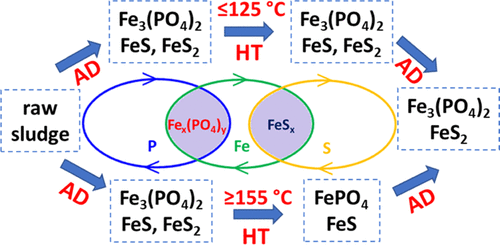当前位置:
X-MOL 学术
›
ACS Sustain. Chem. Eng.
›
论文详情
Our official English website, www.x-mol.net, welcomes your feedback! (Note: you will need to create a separate account there.)
Effect of Interstage Hydrothermal Treatment on Anaerobic Digestion of Sewage Sludge: Speciation Evolution of Phosphorus, Iron, and Sulfur
ACS Sustainable Chemistry & Engineering ( IF 8.4 ) Pub Date : 2020-10-29 , DOI: 10.1021/acssuschemeng.0c05544 Qian Wang 1 , Chiqian Zhang 2 , Pan Liu 1 , Haesung Jung 1 , Biao Wan 1 , Dhara Patel 1 , Spyros G. Pavlostathis 2 , Yuanzhi Tang 1, 2
ACS Sustainable Chemistry & Engineering ( IF 8.4 ) Pub Date : 2020-10-29 , DOI: 10.1021/acssuschemeng.0c05544 Qian Wang 1 , Chiqian Zhang 2 , Pan Liu 1 , Haesung Jung 1 , Biao Wan 1 , Dhara Patel 1 , Spyros G. Pavlostathis 2 , Yuanzhi Tang 1, 2
Affiliation

|
Anaerobic digestion (AD) with interstage hydrothermal treatment (HT) (i.e., AD–HT–AD) is an emerging technology for energy and nutrient recovery from sewage sludge. Yet, systematic understanding on the speciation evolution of nutrient phosphorus (P) and other redox-sensitive elements iron (Fe) and sulfur (S) during AD–HT–AD is still missing. This study investigated the coupled changes of P, Fe, and S speciation during AD–HT–AD of sewage sludge using complementary chemical extraction, microscopy, and spectroscopy analyses. Results indicated that after the first-stage AD a significant fraction of Fe was present as vivianite in the AD solids due to the microbial reduction of strengite and other Fe(III) species. During HT of the anaerobically digested solids, less vivianite but more strengite formed in the HT hydrochars with increasing HT temperature. Partial auto-oxidation of vivianite by H2O at high HT temperatures (155 and 185 °C) induced the formation of strengite. For the second-stage AD, more vivianite formed in AD solids as compared to that in their corresponding hydrochars from higher HT temperatures (155 and 185 °C). Regarding S speciation, both AD stages and HT favored the formation of iron sulfides. Results from this study suggest that the cycling of both P and S is strongly coupled with Fe chemistry. This study sheds light on the reaction mechanisms during AD–HT–AD of sewage sludge and the nutrient recycling and reclamation options for sewage sludge management.
中文翻译:

级间水热处理对污水污泥厌氧消化的影响:磷,铁和硫的形态演变
阶段间水热处理(HT)(即AD–HT–AD)的厌氧消化(AD)是一种从污水污泥中回收能量和养分的新兴技术。然而,关于AD-HT-AD期间营养磷(P)和其他氧化还原敏感元素铁(Fe)和硫(S)的形态演变的系统性认识仍然缺乏。这项研究使用互补化学提取,显微镜和光谱分析方法研究了污泥AD-HT-AD期间P,Fe和S形态的耦合变化。结果表明,在第一阶段AD后,由于硬藻石和其他Fe(III)物种的微生物还原,因此在AD固体中有大量的Fe以堇青石形式存在。在厌氧消化的固体的HT期间,随着HT温度的升高,在HT水炭中形成较少的堇青石,但形成了更多的硬石膏。在高温(155和185°C)的高温下2 O诱导了硬锰矿的形成。对于第二阶段的AD,由于较高的HT温度(155和185°C),与其在相应的碳氢化合物中形成的相比,AD固体中形成了更多的堇青石。关于S形态,AD阶段和HT都倾向于形成硫化铁。这项研究的结果表明,P和S的循环都与铁化学密切相关。这项研究揭示了污水污泥在AD–HT–AD期间的反应机理,以及污水污泥管理的养分循环利用和再生方案。
更新日期:2020-11-09
中文翻译:

级间水热处理对污水污泥厌氧消化的影响:磷,铁和硫的形态演变
阶段间水热处理(HT)(即AD–HT–AD)的厌氧消化(AD)是一种从污水污泥中回收能量和养分的新兴技术。然而,关于AD-HT-AD期间营养磷(P)和其他氧化还原敏感元素铁(Fe)和硫(S)的形态演变的系统性认识仍然缺乏。这项研究使用互补化学提取,显微镜和光谱分析方法研究了污泥AD-HT-AD期间P,Fe和S形态的耦合变化。结果表明,在第一阶段AD后,由于硬藻石和其他Fe(III)物种的微生物还原,因此在AD固体中有大量的Fe以堇青石形式存在。在厌氧消化的固体的HT期间,随着HT温度的升高,在HT水炭中形成较少的堇青石,但形成了更多的硬石膏。在高温(155和185°C)的高温下2 O诱导了硬锰矿的形成。对于第二阶段的AD,由于较高的HT温度(155和185°C),与其在相应的碳氢化合物中形成的相比,AD固体中形成了更多的堇青石。关于S形态,AD阶段和HT都倾向于形成硫化铁。这项研究的结果表明,P和S的循环都与铁化学密切相关。这项研究揭示了污水污泥在AD–HT–AD期间的反应机理,以及污水污泥管理的养分循环利用和再生方案。


























 京公网安备 11010802027423号
京公网安备 11010802027423号